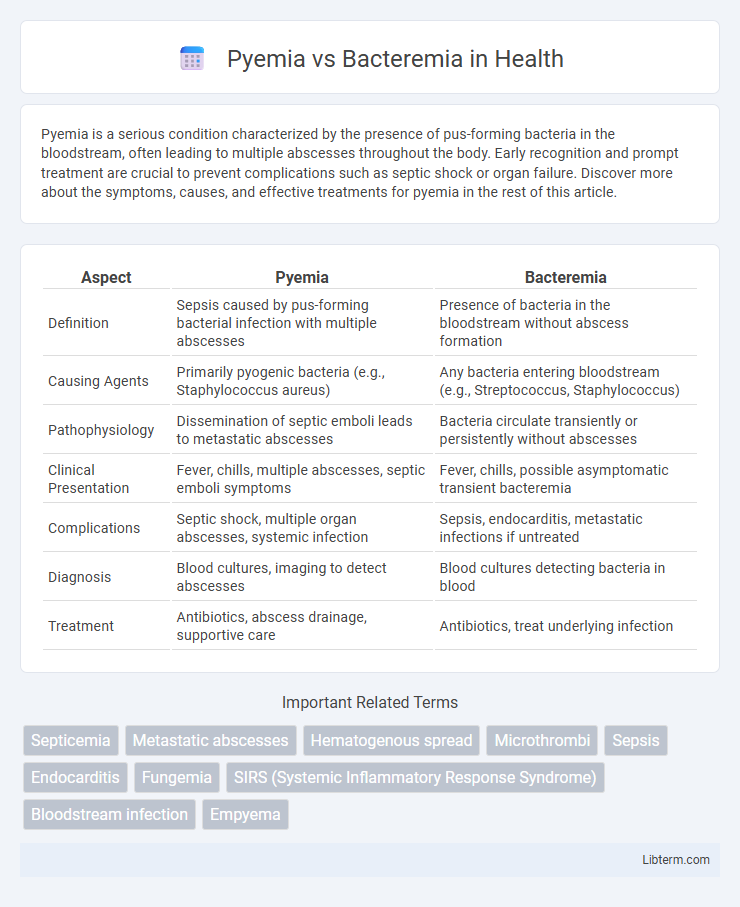Pyemia is a serious condition characterized by the presence of pus-forming bacteria in the bloodstream, often leading to multiple abscesses throughout the body. Early recognition and prompt treatment are crucial to prevent complications such as septic shock or organ failure. Discover more about the symptoms, causes, and effective treatments for pyemia in the rest of this article.
Table of Comparison
| Aspect | Pyemia | Bacteremia |
|---|---|---|
| Definition | Sepsis caused by pus-forming bacterial infection with multiple abscesses | Presence of bacteria in the bloodstream without abscess formation |
| Causing Agents | Primarily pyogenic bacteria (e.g., Staphylococcus aureus) | Any bacteria entering bloodstream (e.g., Streptococcus, Staphylococcus) |
| Pathophysiology | Dissemination of septic emboli leads to metastatic abscesses | Bacteria circulate transiently or persistently without abscesses |
| Clinical Presentation | Fever, chills, multiple abscesses, septic emboli symptoms | Fever, chills, possible asymptomatic transient bacteremia |
| Complications | Septic shock, multiple organ abscesses, systemic infection | Sepsis, endocarditis, metastatic infections if untreated |
| Diagnosis | Blood cultures, imaging to detect abscesses | Blood cultures detecting bacteria in blood |
| Treatment | Antibiotics, abscess drainage, supportive care | Antibiotics, treat underlying infection |
Introduction to Pyemia and Bacteremia
Pyemia is a severe form of sepsis characterized by multiple abscesses caused by the spread of pus-forming bacteria in the bloodstream, often leading to metastatic infections. Bacteremia refers to the presence of bacteria in the bloodstream, which can be transient, intermittent, or persistent, and may or may not result in systemic infection. Both conditions involve the dissemination of bacteria, but pyemia specifically involves the formation of suppurative lesions, making it a more complicated and severe clinical state.
Defining Pyemia: Causes and Characteristics
Pyemia is a severe form of bacteremia characterized by the presence of pus-forming bacteria in the bloodstream, leading to widespread abscess formation and septic emboli. Common causes of pyemia include infections from abscesses, surgical wounds, or suppurative thrombophlebitis, often involving pathogens such as Staphylococcus aureus. Unlike general bacteremia, pyemia results in metastatic infections throughout the body, causing systemic inflammation and multiple organ involvement.
Bacteremia: Overview and Etiology
Bacteremia refers to the presence of bacteria in the bloodstream, often resulting from infections such as urinary tract infections, pneumonia, or invasive medical procedures. It can lead to systemic inflammatory response and sepsis if untreated, posing significant risks to immunocompromised patients or those with underlying health conditions. Unlike pyemia, which involves suppurative emboli spreading infection, bacteremia primarily denotes a transient or persistent bacterial presence in blood without localized abscess formation.
Key Differences Between Pyemia and Bacteremia
Pyemia is a type of sepsis characterized by widespread abscess formation due to metastatic suppuration from septic emboli, whereas bacteremia refers to the presence of bacteria in the bloodstream without necessarily causing abscesses. Pyemia typically involves multiple localized infections and systemic toxicity, in contrast to bacteremia, which may be transient and asymptomatic or lead to systemic infection. The key difference lies in pyemia's development of abscesses and septic emboli, while bacteremia is primarily the detection of bacteria circulating in the blood.
Clinical Manifestations of Pyemia
Pyemia presents with clinical manifestations such as recurrent high fevers, chills, and septic thrombophlebitis due to widespread metastatic abscesses from infected emboli. Patients often exhibit signs of systemic toxicity including malaise, tachycardia, and localized abscess formation in organs like the lungs, liver, or kidneys. Unlike bacteremia, which may be transient and asymptomatic, pyemia involves persistent bacteremia with purulent emboli causing progressive tissue destruction and organ dysfunction.
Signs and Symptoms of Bacteremia
Bacteremia is characterized by signs such as fever, chills, rapid heartbeat, and low blood pressure, often accompanied by malaise and sweating. Unlike pyemia, which involves pus-forming infections and multiple abscesses, bacteremia primarily presents with systemic symptoms related to bacteria circulating in the bloodstream. Early detection of bacteremia signs is crucial to prevent severe complications like sepsis and septic shock.
Diagnostic Approaches for Both Conditions
Diagnostic approaches for pyemia involve blood cultures combined with imaging techniques such as ultrasound, CT scans, or MRI to detect metastatic abscesses characteristic of disseminated infection. Bacteremia diagnosis primarily relies on multiple sets of blood cultures taken before antibiotic administration to identify the presence and type of bacteria in the bloodstream. Both conditions require timely laboratory identification and clinical correlation to guide effective antimicrobial therapy and prevent complications.
Complications Associated with Pyemia and Bacteremia
Pyemia often leads to multiple abscess formations throughout the body due to septic emboli originating from infected thrombi, causing severe organ damage and systemic septic shock. Bacteremia, while sometimes transient and asymptomatic, can escalate to life-threatening conditions such as septicemia, endocarditis, and metastatic infections if bacteria persist in the bloodstream. Complications of pyemia are typically more severe and localized compared to the widespread risks associated with bacteremia.
Treatment Strategies and Management Options
Pyemia treatment involves aggressive antibiotic therapy targeting the causative organisms, coupled with surgical drainage of abscesses when necessary to manage widespread septic emboli. Bacteremia management focuses on prompt identification of the infectious source, appropriate intravenous antibiotics based on culture sensitivities, and supportive care to prevent progression to sepsis. Monitoring for complications such as endocarditis or metastatic infections is critical in both conditions to optimize patient outcomes.
Prognosis and Prevention: Pyemia vs Bacteremia
Pyemia, a severe form of bacteremia characterized by the presence of metastatic abscesses, generally has a poorer prognosis due to widespread infection and septic emboli may lead to organ damage, whereas uncomplicated bacteremia often responds well to timely antibiotic therapy with a more favorable outcome. Prevention of pyemia centers on early detection and aggressive treatment of primary infections, strict aseptic techniques during invasive procedures, and prompt management of bacteremia to inhibit metastatic spread. Effective bacteremia prevention includes maintaining sterile catheter use, timely removal of infectious sources, and comprehensive antibiotic stewardship to reduce bloodstream infection risks.
Pyemia Infographic

 libterm.com
libterm.com